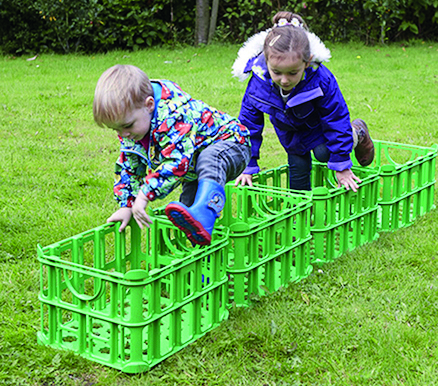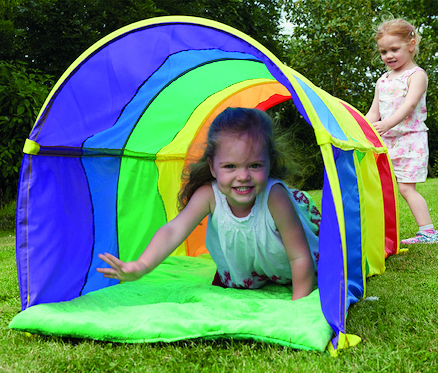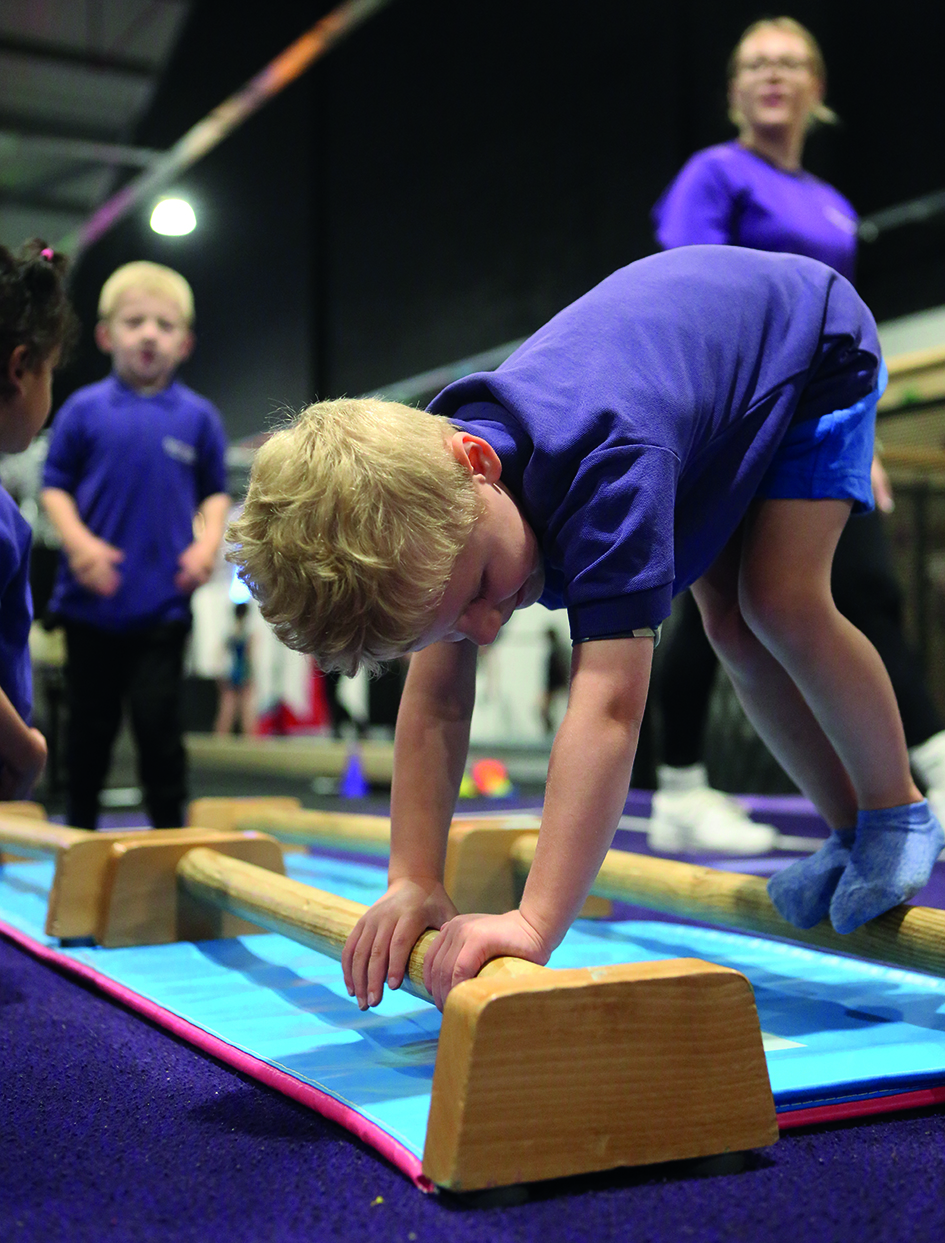
Children are biologically programmed to use their whole bodies to explore and interact with their physical environment. Through crawling, walking, running, rolling, jumping and balancing, they are using their large muscles, or gross motor skills, which is the basis for ‘all other more complex skills’ – such as swimming or football – according to Dr Lala Manners of Active Matters.
‘Offering children access to environments and resources that can develop these skills will support children's agility, core strength, stability, spatial awareness and co-ordination. Without these essential skills, children's language and social and emotional development may be compromised,’ she adds.
Tania Swift, director of B Inspired, which delivers training in physical development and play-based learning to early years practitioners, says that although children do not necessarily need resources to be physically active, certain pieces of equipment can ‘enhance children's development’ and make activities more engaging. ‘Using props to accompany movement activities can act as visual prompts to “explain” new concepts to children. For example, using a balloon as a prop, practitioners can ask children to stretch high into the sky like the balloon; squat down on the floor as the balloon falls; make themselves “big” as they blow up the balloon and run around and fall down as the air is let out.’
FREE PLAY
Opportunities for movement can be ‘threaded’ throughout the day in all activities the children are taking part in, according to Manners. ‘Even if they are role-playing being asleep or being hurt, there's a huge element of movement going on. To be still and remain alert is physically demanding and requires a high degree of muscular strength and control.’
When arriving or leaving the setting, place stickers at different heights along a wall for children to touch as they enter or place a line of masking tape on the floor to walk along in different ways as they leave. Or include ‘active maths’ sessions, where children can jump to number songs or make shapes with their bodies. Babies will need daily ‘tummy time’ to develop their muscles for sitting and crawling.
Manners advises settings to ensure there are a ‘wide range’ of opportunities to move inside and outdoors ‘freely’ throughout the day, and allow children to enjoy risky play. ‘Children need to know they will be supported and not censured.’



PLANNED ACTIVITIES
Although it is important for children to develop their physical skills naturally through child-directed play, practitioners can also offer ‘simple, engaging activities’, Swift says. As outlined in Minmoov.com, an online movement-based toolkit, she advises practitioners to identify three basic physical skills a week – jumping, crawling, bending, galloping, skipping and catching – and plan activities around them.
She explains, ‘It could involve setting up an animal obstacle course or creating an active story. For example, on a “farm”, children can gallop like a horse, squat down to drive a tractor, roll around like a pig in the mud….’
Swift advises practitioners to have ‘quick backup resources’ to hand that encourage movement: music, bubbles, balls and beanbags. She says, ‘I use a large piece of elastic which children hold onto in a circle and move around in different ways.’
Here are some examples of how spontaneous play opportunities can support gross motor development:
- Crawling: Helps infants develop their upper body strength and co-ordination. Try using TTS's Rainbow Toddler Crawl Tunnel, £41.99, or place TickiT's Sensory Reflective Colour Burst Balls, £23.99, within easy reach.
- Walking: This whole body movement helps children develop their balance, co-ordination and strength. Walking to local green spaces can help build stamina. Give babies opportunities to crawl or roll around in the grass.
- Running and jumping: Vital for healthy bone development, coordination, spatial awareness and exercising the cardiovascular system. Try TTS's Hula Hoops Set 12pk, £19.99. Or children will love jumping off TTS's Creative Construction Crates, £16.99.
- Climbing: Activities that encourage children to cross the midline – using both sides of the body – such as running, digging, jumping and climbing help the brain to build neurological pathways and are a prerequisite for developing cognitive skills such as reading and writing. Try Cosy's Ladder Cubes Nest Travalong, £365, or its Monkey Bars Many Ways, £539. Indoors, try TTS's Pickler Inspired Climbing Set, £437.99.
- Balancing: Kicking a ball, riding a bike and using a knife and fork all require co-ordination skills that are learnt by maintaining stability and control over one's body. Try Muddy Faces’ Balance Set, £89.99, or its Wooden Stepping Stones, £27.59. Early Years Resources’ Wooden Balance Beams and Six Small Tyres, £87.99, are great for creating obstacle courses.
- Manipulating objects: Children use their whole bodies to lift heavy objects, such buckets of water or sand, or use their arms and legs to push or pull objects. Set up obstacle courses with loose parts, or try Cosy's Loose Parts Obstacle Course, £455. Try Minmoov's Elastic Fantastic, £9.99, or its set of 18 Mini Moves Cards, £18. During water play, use TickiT's Translucent Colour Buckets, £15.99, or try its Giant Catch Net, £71.99, for throwing and kicking games.
CASE STUDY: Gymfinity Kids Chatham Nursery
 Gymfinity Kids’ chain of three nurseries focuses on ‘movement, development and nourishment’ to enhance children's wellbeing. Children attending the settings, which are based at Gymfinity Kids’ gymnastics and ninja clubs, spend 60 minutes each day taking part in structured play-based movement activities in the fully equipped clubs with sprung floors, balance beams, crash mats, soft blocks, vaults, bars, trampolines and giant foam pits.
Gymfinity Kids’ chain of three nurseries focuses on ‘movement, development and nourishment’ to enhance children's wellbeing. Children attending the settings, which are based at Gymfinity Kids’ gymnastics and ninja clubs, spend 60 minutes each day taking part in structured play-based movement activities in the fully equipped clubs with sprung floors, balance beams, crash mats, soft blocks, vaults, bars, trampolines and giant foam pits.
Imogen Mohammed, the group's movement ambassador, says, ‘The sessions, led by qualified gymnastic coaches, are based around a ten-week programme of balance, flexibility, co-ordination and strength. We start with a warm-up to raise heart rates. We then move on to a challenge or circuit, where they might line up and take their turn to grab a beanbag and place it in the corresponding-coloured hoop, jumping or bunny hopping along the way. We have lots of resources for games and activities: ribbons, batons, egg and spoons. They learn how to do forward rolls – using soft blocks to support their necks – how to jump from different heights and touch their toes.
‘The different surfaces in the gym, along with the equipment, helps children build their physical strength and co-ordination. The sprung floor is great for new walkers as it strengthens their legs and helps them learn to walk with confidence. One of the most exciting activities for the children is the giant foam pit. This is introduced gradually but they love to pretend to be aeroplanes running along the trampoline, down the slope and jumping into the pit.’
Jodie Brownlow, manager at Gymfinity Kids Chatham, says, ‘All sessions are attended by a Level 3 practitioner and all the games and activities link into the EYFS planning, with books and songs incorporated into the sessions.
‘We've noticed a huge change in children's confidence. One little boy was scared to walk on a balancing beam that was 20cm off the floor. After a few sessions he gained his confidence and a year later he freely climbs and explores and fully participates in risky play.’









